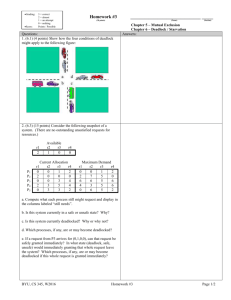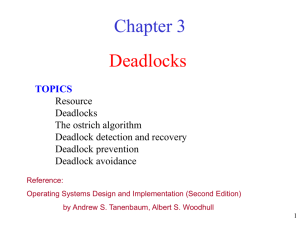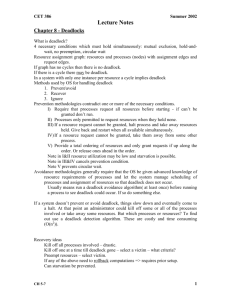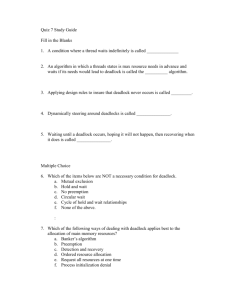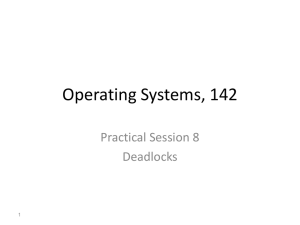Deadlocks - Department of Computer Science and Information
advertisement
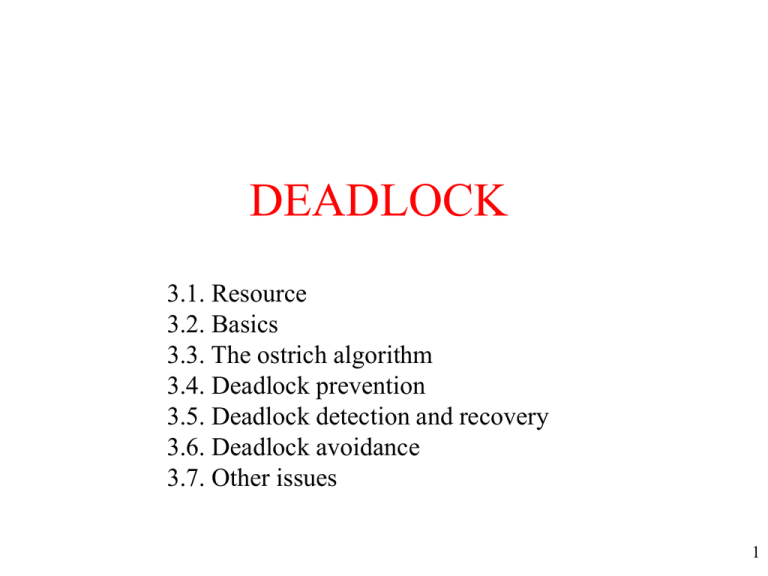
DEADLOCK 3.1. Resource 3.2. Basics 3.3. The ostrich algorithm 3.4. Deadlock prevention 3.5. Deadlock detection and recovery 3.6. Deadlock avoidance 3.7. Other issues 1 Resources • Examples of computer resources: - hardware device (e.g. printers) or - piece of information(e.g. locked record in a database) • Suppose a process holds resource A and requests resource B and at same time another process holds B and requests A Both are blocked and remain so. 2 Resources (1) • Preemptable resources – can be taken away from a process with no ill effects, e.g. main memory • Nonpreemptable resources – will cause the process to fail if taken away, e.g. CDRom 3 Resources (2) • Sequence of events required to use a resource 1. request the resource 2. use the resource 3. release the resource • Must wait if request is denied – – • requesting process may be blocked may fail with error code System calls: request or open a special file 4 Introduction to Deadlocks • Formal definition : A set of processes is deadlocked if each process in the set is waiting for an event that only another process in the set can cause. • Usually the event is release of a currently held resource • None of the processes can … – run – release resources – be awakened 5 Resource Allocation Graph • Directed graph with process and resource nodes, arrows indicate request and allocation a) resource R assigned to process A b) process B is requesting/waiting for resource S c) process C and D are in deadlock over resources T and U 6 How Deadlock Occurs A B C 7 A Deadlock-free Run (o) (p) (q) 8 Four Conditions for Deadlock 1. Mutual exclusion condition each resource assigned to at most one process 2. Hold and wait condition process holding resources can request additional resource 3. No preemption condition previously granted resources cannot forcibly taken away 4. Circular wait condition must be a circular chain of two or more processes such that each is waiting for resource held by next member of the chain 9 Handling Deadlocks Strategies for dealing with Deadlocks 1. 2. 3. 4. just ignore the problem altogether prevention by negating one of the four necessary conditions detection and recovery dynamic avoidance by careful resource allocation 10 The Ostrich Algorithm • Pretend there is no problem • Reasonable if – deadlocks occur very rarely – cost of prevention is high • UNIX and Windows takes this approach • It is a trade off between – convenience – correctness 11 Deadlock Prevention Attacking the Mutual Exclusion Condition • Some devices (such as printer) can be spooled – only the printer daemon uses printer resource – thus deadlock for printer eliminated • Not all devices can be spooled • Principle: – avoid assigning resource when not absolutely necessary – as few processes as possible actually claim the resource 12 Attacking the Hold and Wait Condition • Require processes to request resources before starting – a process never has to wait for what it needs • Problems – may not know required resources at start of run – also ties up resources other processes could be using • Variation: – process must give up all resources – then request all immediately needed 13 Attacking the No Preemption Condition • This is not a viable option • Consider a process given the printer – halfway through its job – now forcibly take away printer – !!?? 14 Attacking the Circular Wait Condition (1) (a) (b) (a) Linearly ordered resources (b) A resource graph A process can request resources according to their ordering only. 15 Attacking the Circular Wait Condition (1) Summary of approaches to deadlock prevention 16 Detection with One Resource of Each Type (1) Deadlock occurs if and only if there is a cycle in the resource allocation graph. Cycles can be checked by a depth-first search. 17 Detection with Multiple Resources of Each Type (1) Deadlock occurs if each process’ request is unsatisfiable. 18 An example for the deadlock detection algorithm Process 3’s request can be granted. What happens if process 3 wants an additional CD-Rom? 19 Recovery from Deadlock (1) • Recovery through preemption – take a resource from some other process – depends on nature of the resource • Recovery through rollback – checkpoint a process periodically – use this saved state – restart the process if it is found deadlocked 20 Recovery from Deadlock (2) • Recovery through killing processes – – – – crudest but simplest way to break a deadlock kill one of the processes in the deadlock cycle the other processes get its resources choose process that can be rerun from the beginning 21 Deadlock Avoidance Resource Trajectories Two process resource trajectories 22 Safe State • A state is safe if it is not deadlocked and there is some scheduling order in which every process can run to completion even if they request their maximum number of resources immediately. • An unsafe state is a state that is not safe. • Note that unsafe does not necessary mean deadlocked. 23 Avoidance for one resource of each type • Start with the resource allocation graph representing the current state. • Indicate every possible request with an arrow. • Grant a request only if the resulting graph is free of cycles. 24 Banker's Algorithm for Multiple Resources of each type A safe state (e.g. D, A, E, B, C). Should we allocate the two available scanners to processes B and E? 25 Two-Phase Locking • Phase One – process tries to lock all records it needs, one at a time – if needed record found locked, start over – (no real work done in phase one) • If phase one succeeds, it starts second phase, – performing updates – releasing locks • Note similarity to requesting all resources at once • Algorithm works where programmer can arrange that a program can be stopped and restarted. 26


